Light interception and radiation use efficiency response to tridimensional uniform sowing in winter wheat
2018-03-07TAOZhiqiangWANGDemeiMAShaokangYANGYushuangZHAOGuangcaiCHANGXuhong
TAO Zhi-qiang, WANG De-mei, MA Shao-kang, YANG Yu-shuang, ZHAO Guang-cai, CHANG Xu-hong
Institute of Crop Sciences, Chinese Academy of Agricultural Sciences/Key Laboratory of Crop Physiology and Ecology, Ministry of Agriculture, Beijing 100081, P.R.China
1.lntroduction
Sowing pattern is an important factor in the sustainable development of agriculture, as it influences plant distribution in the field, which in turn affects traits related to photosynthesis and yield (Liu et al.2011; Yang et al.2014).Adjusting spacing and planting density are two sowing methods often used to improve crop growth and development (Zhang et al.2016).Drilling (D) improves wheat population structure and yield, and many experimental studies have demonstrated that adjusting the spacing of plants in the D mode increases canopy radiation use efficiency (RUE) (Wu and Ou 2014).In the so-called tridimensional uniform sowing (U) mode,wheat seeds are evenly distributed on the same soil plane,so no ridges and rows exist after emergence.Plant growth is strong, the number of panicles per unit area is increased compared with D, and light is evenly distributed and fully utilized, resulting in improved yield (Zhao 2016; ICSCAAS 2016).
Light plays an important role in net primary productivity(Du et al.2015).The availability of light depends upon the spatial distribution of the plant population, and the canopy structure in particular.For example, light interception decreases exponentially from the top to the bottom of the canopy, and leaf net photosynthetic rate (Pn) increases gradually from the bottom to the top of the canopy (Niinemets 2007).These changes in light availability in the canopy are the result of differences in leaf and canopy structural characteristics (Zhang et al.2016).In the growing canopy,leaf traits, such as leaf area index (LAI) and leaf mass per unit area (LMA), are important factors associated with the ability of leaves to collect light and photosynthesize (Yang et al.2017).In general, crop development causes differences in light interception.For example, dry matter (DM) production is always positively correlated with light interception (Zhang et al.2016).The canopy extinction coefficient (K) is an important factor in crop development.This value depends on the canopy structure, species type, and sowing pattern(Soleymani 2016).Intercepted photosynthetically active radiation (IPAR) and radiation use efficiency (RUE) are two other important factors in crop development.RUE is the slope of the linear relationship between biomass production and IPAR (Wang et al.2015).Limited productivity is often due to low RUE.Studies have demonstrated that RUE is determined by variety, temperature (Chaudhary et al.2016), water availability (Yang et al.2017), and nutrition(Zhu et al.2016).
An evenly distributed population is considered to be a good sowing pattern for efficiently capturing the available light resources (Sharratt and McWilliams 2005).In this study, the IPAR and RUE of different planting densities and different sowing patterns were investigated in winter wheat.The objectives were to: (1) compare the effects of canopy on light interception for different planting densities under U and D; and (2) analyze the response of wheat RUE to different planting densities under U.
2.Materials and methods
2.1.Field experiment design
This study was conducted at the Shunyi Experimental Station of the Institute of Crop Sciences, Chinese Academy of Agricultural Sciences in Beijing (40°13´N, 116°65´E)during the wheat growing season from October 2014 to June 2015, and October 2015 to June 2016.The study area is located in a warm temperate, semi-humid, and semi-arid monsoon climate with ample light and heat and an annual total radiation of 5 433 kJ cm-2, annual sunshine hours of 2 608 h, annual mean temperature of 12.3°C, and an altitude of 50.1 m.Mean annual precipitation was 480.7 mm, which was mainly concentrated in July to September when the temperatures were the highest.Monthly mean temperature and precipitation during the growing season are shown in Fig.1.The winter wheat crop was irrigated with 75 mm water at the jointing and flowering stages.The soil type was sandy loam soil consisting of approximately 50% sand, 10% clay,and 40% silt (IUSS Working Group WRB 2014).The 0-20 cm soil layer contained 13.5 g kg-1organic matter, 95.4 mg kg-1available nitrogen, 13.3 mg kg-1available phosphorus, and 102.5 mg kg-1available potassium.
The variety of wheat used was Zhongmai 8, which has a medium tiller level.Two sowing patterns were used: D and U (Fig.2).Four planting densities were tested: 1.8, 2.7,3.6, and 4.5 million plants ha-1.A split plot design was used in the experiment; the main plot was the sowing pattern,and the subplot was the planting density in triplicate.The area of the test plot was 15 m2(10 m×1.5 m).Row spacing under the D mode was 15 cm.For tridimensional uniform sowing, fertilizers were distributed evenly in the loose soil after rotary tillage.Next, the seeds were uniformly distributed in the loose soil using a seed plate, through a compaction so that the seeds, fertilizers and soil were thoroughly combined and uniformly distributed in the compacted soil, and the seeds were covered with a thin layer of soil.A second compaction was done in order to ensure that the soil below the seeds was loose, the soil around the seeds was compacted, and that there was a layer of compacted soil above the seeds.Tridimensional uniform distribution refers to the even distribution of seed,fertilizer, and soil.Each seed has a balanced growth environment.The presence of compacted soil above and loose soil below, not only prevents air leakage but also reduces water evaporation.The nitrogen, phosphate, and potash fertilizers contained urea (N 46%), diammonium phosphate (P2O546%, N18%), and potassium chloride(K2O 60%), respectively.N was applied at a ratio of 1:1 as a base fertilizer and as a top dressing at the jointing stage.P(P2O5) and K (K2O) were applied as base fertilizers at 150 kg each per hectare.The study plot was subjected to regular weeding, and insecticides were used.Seeds were selected before sowing and dressed using a mixture of 100 mL phoxim 50% EC (Huayu pesticide Co., Ltd., Tianjin,China), 5 kg water, and 50 kg wheat seed.For the D sowing pattern, sowing was done using a Wintersteiger Air Suction Precision Plot Seeder (Wintersteiger Trading Co., Ltd., Austria).For the U sowing pattern, sowing was done using a tridimensional uniform sowing machine(jointly developed by Institute of Crop Sciences, Chinese Academy of Agricultural Sciences and Zhonghengjinfeng Agricultural Technology Co., Ltd., China).Winter wheat was sown on 12 October 2014 and 15 October 2015, and harvested on 9 June 2015 and 11 June 2016, respectively.

Fig.1 Monthly mean temperature (T) and precipitation (P)during the 2014-2015 and 2015-2016 growing seasons.
2.2.Plant sampling, measurements, and calculations
Light interceptionThe canopy PAR and LAI were measured using a SUNSCAN Canopy Analysis System(Delta Inc., England).Canopy IPAR was calculated from the difference between PAR of the upper and lower canopy(Shi et al.2005):

Where, PAR is the total photosynthetically active radiation measured at the top of the canopy, and BPAR is the photosynthetically active radiation measured at the bottom of the canopy.At the reviving and jointing stages, wheat seedlings were smaller and the spacing was wider under the D treatment.During the reviving stage, PAR and BPAR were measured from three randomly selected lines for each treatment; the mean of the three measurements was used for analyses.Measurements were completed for each row.Measurements were taken for the left and right sides and then averaged.During the jointing stage, three points in the middle of each row were selected for measurement, and the results were averaged (Shi et al.2005).Measurements were obtained in the morning from 9:00-11:00 and in the afternoon from 13:00-15:00.
Accumulated photosynthetic active radiation (PARa)The following formula was used to calculate PARa:
F (%)=(1-BPAR/PAR)×100

Fig.2 Wheat seedlings at the tillering stage before winter grown under drilling (D, left) and tridimensional uniform sowing (U, right).

Where, Fdis the average daily light interception fraction and PARdis the daily photosynthetically active radiation measured by the weather station near the test site, t is the number of days after sowing to maturity, and F is the fractional amount of radiation intercepted.PARa,tis the accumulated photosynthetic active radiation at days after sowing to maturity.
Radiation use efficiencyThe following formula was used to calculate RUE:

Where, DMdand DMd-1are dry matter weights at days d and d-1, respectively, and PARdand PARd-1are PAR at days d and d-1, respectively.
Calculation of leaf mass per unit areaLMA was calculated using the following formula:
LMA=DM/LA
Where, DM is the dry matter weight of the flag leaf and LA is the measured leaf area.We used an LI-3000C Portable Area Meter (Beijing Ecotek Technology Co., Ltd., China) and measured 20 flag leaves randomly in each plot.The leaves were dried at 80°C, and each leaf was weighed.
Calculation of the extinction coefficient (K)K was calculated using the formula:
BPAR=PAR×e-K×LAI
Where, PAR is the total photosynthetically active radiation in the upper part of the canopy, BPAR is the photosynthetically active radiation in the bottom of the canopy, and LAI is the leaf area index.
2.3.Statistical evaluation
The effects of treatments and their interactions were evaluated across years for all described traits with oneway ANOVA using SPSS 18.0 (SPSS Inc., Chicago, IL,USA).Treatment means were compared using Duncan’s multiple range tests at the 5% significance level.The contributions (Eta2) were calculated using a general linear model.Correlation was assessed with Pearson correlation analysis.Figures were prepared using Sigmaplot 12.5(Systat Software, Inc., San Jose, CA, USA).
3.Results
3.1.Light interception
The PAR of the canopy ranged from 1 135.3 to 1 572.6 μmol m-2s-1and from 1 066.7 to 1 597.4 μmol m-2s-1from 165 days after planting to 225 days after planting in 2015 and 2016(Fig.3).For both the U and D planting modes, the plot of IPAR was parabolically shaped (Fig.4), and IPAR increased as planting density increased.IPAR increased gradually until 209 days after sowing for both sowing patterns and for all densities.IPAR increased 0.2-5.1% in U compared to in D (Fig.5).During this period, the U mode with a density of 4.5 million plants ha-1treatment had the highest IPAR,followed by the U mode with 3.6 million plants ha-1, the U mode with 2.7 million plants ha-1, the D mode with 4.5 million plants ha-1, the D mode with 3.6 million plants ha-1, the U mode with 1.8 million plants ha-1, the D mode with 2.7 million plants ha-1, and the D mode with 1.8 million plants ha-1.The effect of the sowing pattern×planting density interaction on IPAR was significant (P<0.05) (Table 1).Sowing pattern had the largest contribution (Eta2=0.750) to total variation in IPAR.These results indicate that the highest planting density population under the U mode enhanced canopy interception of light, leading to a higher PAR compared with the same planting density under the D mode.
3.2.Leaf area index and leaf mass per unit area
For most crops, IPAR is highly dependent on LAI.Figs.6 and 7 show that LAI of winter wheat changed over time.There were significant differences in LAI between the different planting densities and modes.But the effect of the sowing pattern×planting density interaction on LAI was not significant(Table 2).The largest LAI was observed 209 days after planting in the U mode with a density of 4.5 million plants ha-1(7.25 million plants ha-1in 2015 and 7.42 million plants ha-1in 2016), followed by the U mode with 3.6 million plants ha-1, the U mode with 2.7 million plants ha-1, the D mode with 4.5 million plants ha-1, the D mode with 3.6 million plants ha-1, the U mode with 1.8 million plants ha-1, the D mode with 2.7 million plants ha-1, and the D mode with 1.8 million plants ha-1(Fig.6).Once the maximum LAI was reached, it began to drop regardless of treatment.
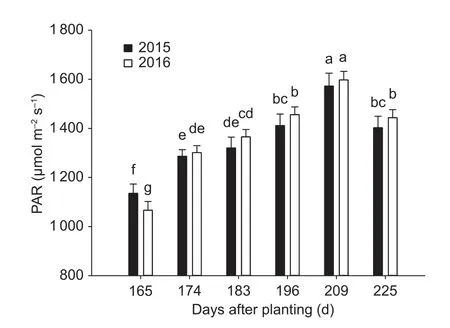
Fig.3 Mean photosynthetically active radiation in 2015 and 2016.The error bars represent standard deviations.PAR,photosynthetically active radiation.Letters are significant differences (P<0.05).
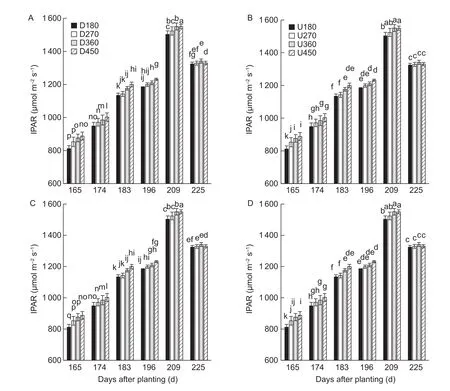
Fig.4 Winter wheat canopy interception of the photosynthetic active radiation (IPAR) under different sowing patterns and different planting densities in 2015 (A and B) and 2016 (C and D).In A and C, D180, D270, D360, and D450 indicate the drilling sowing pattern with a density of 1.8, 2.7, 3.6, and 4.5 million plants ha-1, respectively.In B and D, U180, U270, U360, and U450 indicate the tridimensional uniform sowing pattern with a density of 1.8, 2.7, 3.6, and 4.5 million plants ha-1, respectively.The error bars(SD) represent the overall distribution of IPAR data.Letters are significant differences (P<0.05).
Leaf mass per unit area (LMA) decreased after flowering in all treatments (Figs.8 and 9).LMA was the highest in the U mode with a density of 3.6 million plants ha-1, and the lowest in the D mode with a density of 4.5 million plants ha-1(Fig.8).Mean LMA differed significantly (P<0.05)between the different densities regardless of sowing pattern(Fig.8).Mean LMA in the D mode was 4.61 g m-2(Fig.9).The highest LMA was 6.22 g m-2at a density of 1.8 million plants ha-1, and LMA decreased with increasing density(Fig.8).Mean LMA under the U mode was 4.85 g m-2, and the highest LMA was 6.38 g m-2at a density of 3.6 million plants ha-1, followed by 2.7, 1.8, and 4.5 million plants ha-1(Fig.9).The effect of the sowing pattern×planting density interaction on LMA was significant (P<0.01) (Table 1) and had the largest contribution (Eta2=0.573) to total variation in LMA.These results indicate that the U mode was more conducive to improving LMA than the D mode, particularly at higher planting densities (up to 3.6 million plants ha-1), but it was not suitable for improving LMA at the highest density(4.5 million plants ha-1).
3.3.Canopy extinction coefficient
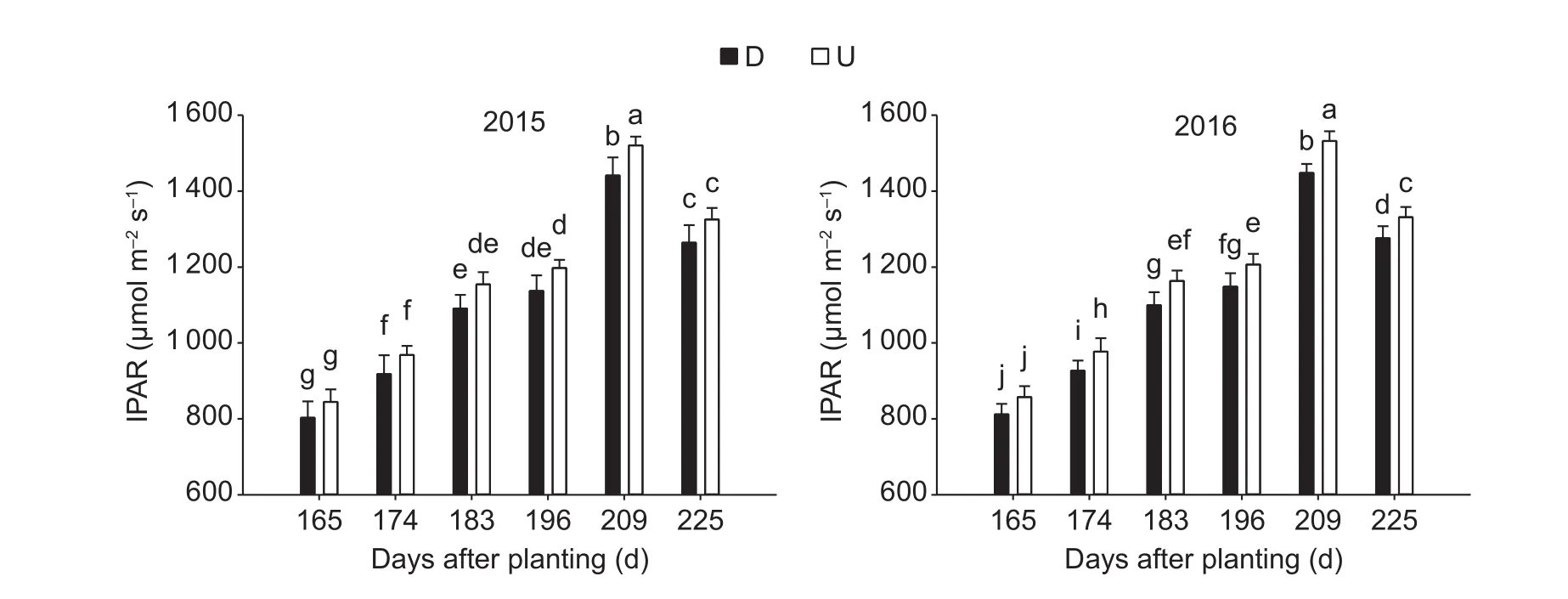
Fig.5 Winter wheat canopy interception of the photosynthetic active radiation (IPAR) under different sowing patterns in 2015 and 2016.These values are the average across planting densities under the drilling (D) and tridimensional uniform sowing (U) patterns.The error bars (SD) represent the overall distribution of IPAR data.Letters are significant differences (P<0.05).

Table 1 Results of ANOVA of the effects of sowing pattern (SP), plant density (PD), and year (Y) on wheat grain yield, yield components, and radiation use efficiency (RUE), photosynthetic active radiation intercepted by the canopy (IPAR), leaf area index(LAI), leaf mass per unit area (LMA), and canopy extinction coefficient (K) in 2015-2016
The vertical distribution of leaf area, leaf angle, and the vertical decline in light are reflected by the canopy extinction coefficient (K) value.K is calculated based on the interception ratio of IPAR and the dynamic change in LAI.The K value was expressed as a straight line (Figs.10 and 11).The schematic regression of winter wheat canopy extinction coefficient (K) by fraction of Ln(TPAR/PAR) and LAI, K is negatively correlated with LAI.The K values were the lowest for the planting density of 4.5 million plants ha-1treatment and the highest for the 1.8 million plants ha-1treatment, regardless of sowing pattern.The U mode K values were lower than the D mode values at the same planting density.The effect of the sowing pattern×planting density interaction on IPAR was significant (P<0.05)(Table 1).Planting density had the largest contribution(Eta2=0.879) to total variation in K.Overall, planting in the U mode at high density reduced the K value.
3.4.Grain yield and yield components
The highest grain yield for both years was obtained for the U mode with a planting density of 3.6 million plants ha-1.In the D mode, grain yield decreased as planting density increased (Table 2).However, in the U mode, grain yield increased with planting density, exhibiting a single peak at 3.6 million plants ha-1.Thus, the D mode was not suitable for high planting density, whereas high density planting in the U mode resulted in a high grain yield.For both sowing patterns, the number of spikes per unit area increased with increasing plant density.The increase in the number of spikes was even greater under the U mode than that under the D mode.The highest number of spikes per unit area was observed in the U mode with a planting density of 3.6 million plants ha-1, which is consistent with the grain yield results.The number of grains per spike and 1 000-grain weight decreased as planting density increased under U and D.The effect of the interaction between sowing pattern×planting density on grain yield, the number of spikes per unit area, the number of grains per spike, and 1 000-grain weight was significant (P<0.01 or P<0.05) (Table 1).Sowing pattern×planting density had the largest contribution(Eta2=0.946) to total variation in grain yield.Planting density had the largest contribution to total variation in the number of spikes per unit area (Eta2=0.743), the number of grains per spike (Eta2=0.398), and 1 000-grain weight (Eta2=0.795).
3.5.Radiation use efficiency
The RUE of crops is obtained by linear fitting of aboveground DM and the accumulated IPAR.The highest RUE during both years was observed for the U mode with a density of 3.6 million plants ha-1, and the lowest RUE was observed for the D mode with a density of 4.5 million plants ha-1(Table 2).Significant differences in RUE were found between each of the treatments.The effect of the interaction between sowing pattern×planting density on RUE was significant (P<0.01) (Table 1) and had the largest contribution (Eta2=0.913) to total variation in RUE.RUE decreased as planting density increased under the D mode.However, RUE peaked at a planting density of 3.6 million plants ha-1in the U mode.

Fig.6 Leaf area index (LAI) of winter wheat under different sowing patterns and different planting densities in 2015 (A and B) and 2016 (C and D).In A and C, D180, D270, D360, and D450 indicate the drilling sowing pattern with a density of 1.8, 2.7, 3.6, and 4.5 million plants ha-1, respectively.In B and D, U180, U270, U360, and U450 indicate the tridimensional uniform sowing pattern with a density of 1.8, 2.7, 3.6, and 4.5 million plants ha-1, respectively.The error bars (SD) represent the overall distribution of LAI data.Letters are significant differences (P<0.05).
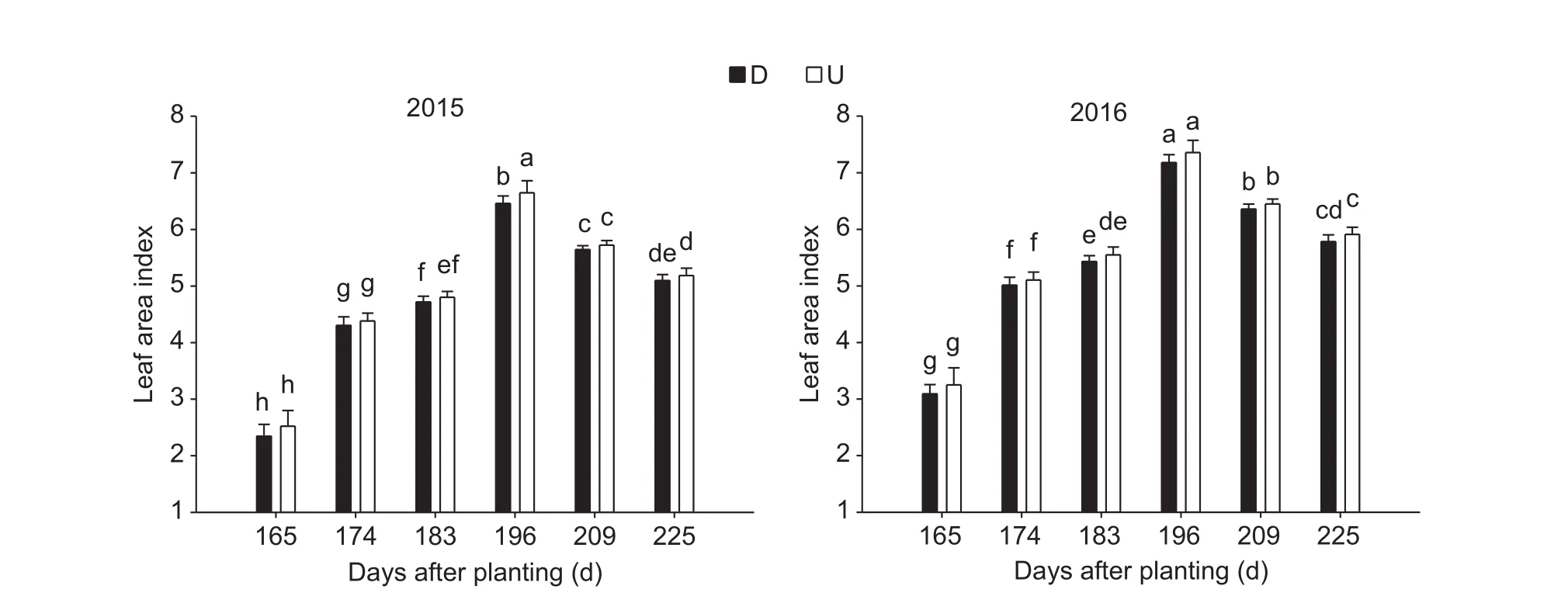
Fig.7 Leaf area index (LAI) of winter wheat under different sowing patterns in 2015 and 2016.Values are the average across planting densities for the drilling mode (D) and tridimensional uniform sowing pattern (U).The error bars (SD) represent the overall distribution of LAI data.Letters are significant differences (P<0.05).

Table 2 Grain yield, yield components, and radiation use efficiency (RUE) of winter wheat under different sowing patterns and planting densities
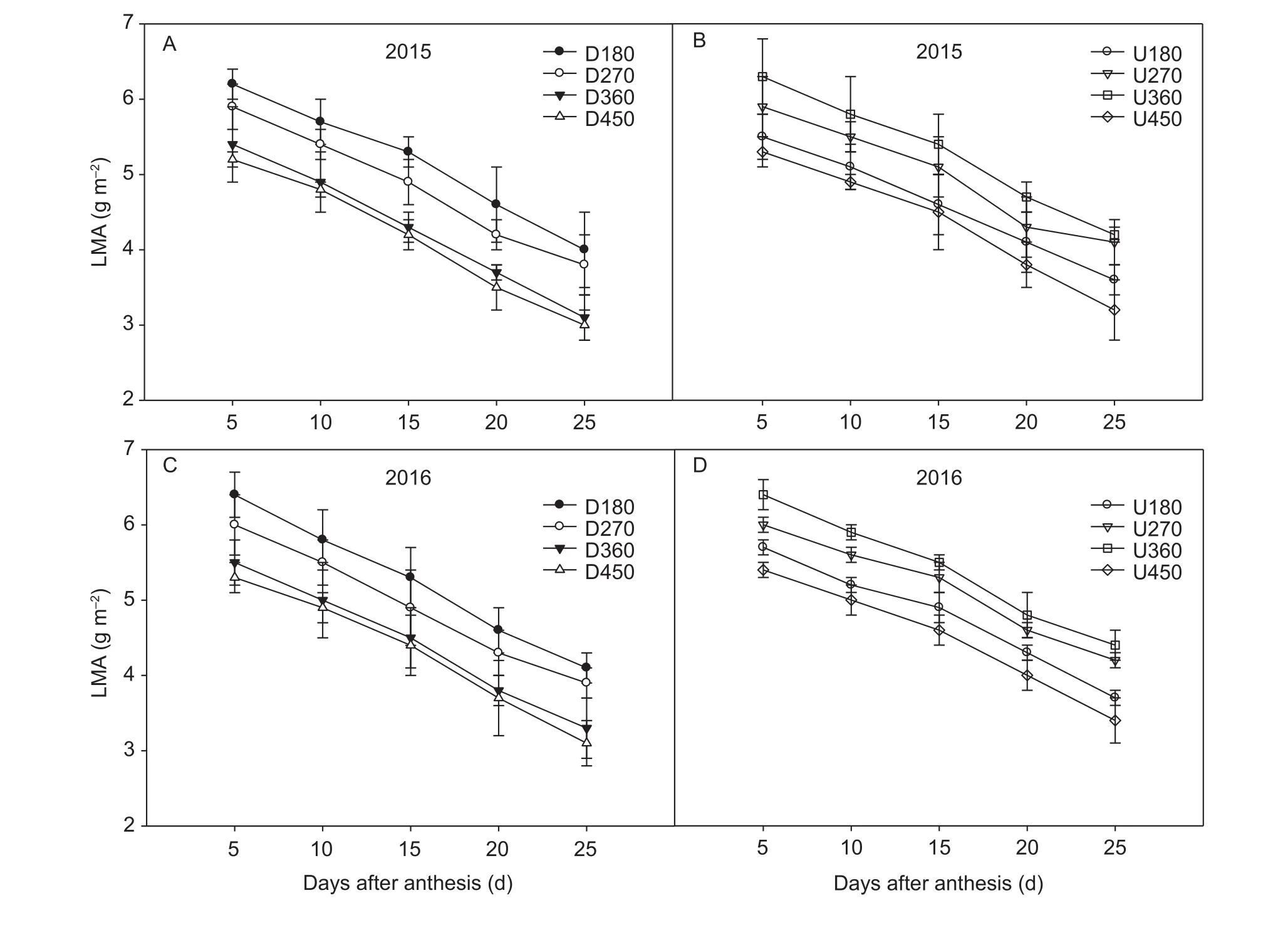
Fig.8 Leaf mass per area (LMA) of winter wheat grown under different sowing patterns and different planting densities in 2015(A and B) and 2016 (C and D).In A and C, D180, D270, D360, and D450 indicate the drilling sowing pattern with a density of 1.8,2.7, 3.6, and 4.5 million plants ha-1, respectively.In B and D, U180, U270, U360, and U450 indicate the tridimensional uniform sowing pattern with a density of 1.8, 2.7, 3.6, and 4.5 million plants ha-1, respectively.The error bars (SD) represent the overall distribution of LMA data.

Fig.9 Leaf mass per area (LMA) of winter wheat grown under different sowing patterns in 2015 and 2016.Values are the average across planting densities for the drilling mode (D) and tridimensional uniform sowing pattern (U).The error bars (SD) represent the overall distribution of LMA data.Letters are significant differences (P<0.05).

Fig.10 The schematic regression of winter wheat canopy extinction coefficient (K) by fraction of Ln(TPAR/PAR) and leaf area index (LAI) for different planting densities under drilling (D) and tridimensional uniform sowing (U) in 2015 (A and B) and 2016 (C and D).In A and C, D180, D270, D360, and D450 indicate the drilling sowing pattern with a density of 1.8, 2.7, 3.6 and 4.5 million plants ha-1, respectively.In B and D, U180, U270, U360, and U450 indicate the tridimensional uniform sowing pattern with a density of 1.8, 2.7, 3.6, and 4.5 million plants ha-1, respectively.The error bars (SD) represent the overall distribution of the data.
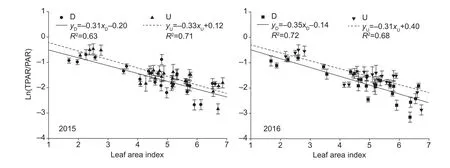
3.6.Correlation analysis
We performed correlation analysis to determine the reason why wheat grain yield increased under different sowing patterns and planting densities.As shown in Table 3, in both 2015 and 2016 LAI was positively correlated with IPAR (P<0.01) and spike number (P<0.05) and negatively correlated with K (P<0.01).In both years, K was negatively correlated with IPAR (P<0.01) and spike number (P<0.05),grain yield was positively correlated with RUE (P<0.01),and RUE was positively correlated with LMA (P<0.01).The results for both years combined show that grain yield was positively correlated with RUE (P<0.01), LMA (P<0.05),and spike number (P<0.05).These results suggest that the increase in grain yield is correlated with increased planting density, increased light interception and utilization, and increased leaf mass per unit area.These increases led to the production of more photosynthetic products that in turn led to significantly increased spike number, and an overall increase in yield.
4.Discussion
The main way to adjust the structure of a crop canopy is to alter the arrangement of plants in the field (Sharratt and McWilliams 2005; Zhang et al.2016).A better canopy structure will affect photosynthetic capacity.A plant population that is uniformly distributed intercepts more radiation (Chen et al.2003).Our results are consistent with this: more PAR was intercepted by the canopy under the U mode than that under the D mode, and a high density and even distribution allowed more PAR interception (Figs.4 and 5).Correlation analysis showed that IPAR was positively correlated with LAI and spike number (P<0.01) (Table 2),showing that increased population density and the uniform distribution of plants allowed the canopy to intercept more light.LAI increased with growth but decreased gradually after reaching a maximum as a result of leaf senescence.The highest IPAR value appeared later than the maximum LAI.This is because leaves did not fall off the stem even though they were aging, resulting in changes in canopy IPAR that were not synchronized with reduced LAI (Kiniry et al.2004).Regardless of the planting mode, LAI increased as planting density increased.Similar LAI values were observed with different IPAR values, which reflect differences in shading.A larger LAI leads to a lower LMA due to a longer leaf shading time compared with no shading or a short shading time (Rosati et al.2001).LMA is sensitive to environmental changes, particularly in intercepted light environments (Liu et al.2016).This is why leaf shading increased with density, while LMA decreased.Our results showed that LMA decreased under the D mode, whereas LMA increased with increasing planting density (from 1.8 to 3.6 million plants ha-1) under the U mode.These results indicate that the U mode is better for planting at high densities because it is less shade from adjacent plants.However, shading may be problematic if planting density is 4.5 million plants ha-1.This density resulted in a substantial decline in LMA for the D mode (Fig.8).The differences in LMA between the different sowing patterns can be attributed to the uniform canopy distribution in the field; the U mode was more conducive to canopy interception and use of light leading to the production of more grain.Our correlation analysis also showed that LMA was positively correlated with RUE (P<0.01).The result showed that U mode is better than D mode for planting at high densities because less leaf shading, and higher LMA is accompanied by a long lifecycle, in this mode allows plants to produce more photosynthetic products for grain.

Table 3Analysisof thecorrelation betweengrain yield, grain yield components,radiationuse efficiency (RUE), photosynthetically activeradiation interceptedbythecanopy(IPAR),leaf area index(LAI), leaf mass perunit area (LMA), andcanopyextinctioncoefficient(K)G yir e ali dn n Sup m ikbe ern p K uee m rr nebe aelrr1 0 w0e0 i-gg hra tin RUEIPARLAILMAKG yir e ali dn n Sup m ikbe ern p K uee m rr nebe aelrr1 0 w0e0 i-gg hra tin RUEIPARLAI LMA K Grain yield1.0000.696-0.1410.3440.870**0.4180.4620.579-0.4041.0000.595-0.1180.1050.890**0.2810.3990.644-0.378 Spike number0.6961.000-0.728*-0.3540.3340.913**0.834*0.022-0.870**0.5951.000-0.823*-0.716*0.3390.6890.801*0.082-0.787*Kernelnumber perear-0.141-0.728*1.0000.4890.127-0.795*-0.5310.2550.632-0.118-0.823*1.0000.840**0.122-0.845**-0.814*0.352-0.876**1 000-grain weight0.344-0.3540.4891.0000.716*-0.562-0.5940.767*0.6550.105-0.716*0.840**1.0000.370-0.496-0.6380.4800.561 RUE0.870**0.3340.1270.716*1.0000.0440.0150.851**0.0100.890**0.3390.1220.3701.0000.1200.1080.864**0.161 IPAR0.4180.913**-0.795*-0.5620.0441.0000.883**-0.280-0.955**0.2810.689-0.845**-0.4960.1201.0000.873**-0.230-0.983**LAI0.4620.834*-0.531-0.5940.0150.883**1.000-0.378-0.961**0.3990.801*-0.814*-0.6380.1080.873**1.000-0.328-0.934**LMA0.5790.0220.2550.767*0.851**-0.280-0.3781.0000.3590.6440.0820.3520.4800.864**-0.230-0.3281.000-0.219 K 0.4040.870**-0.632-0.655-0.0100.955**0.961**-0.3591.0000.3780.787*-0.876**-0.5610.1610.983**0.934**-0.2191.000*, significant at P=0.05;**, significant at P=0.01. Thevaluesin thetable arecorrelation coefficients.16 20 15 20
The canopy K value, which varies with population structure and leaf area index, is an important variable when studying the relationship between canopy structure and solar energy utilization.A reduction in K value with increased planting density has been reported in maize and other species (Francescangeli et al.2006; Ruiz and Bertero 2008).Our results indicate that K was negatively correlated with IPAR (P<0.01) and spike number (P<0.05), and K value decreased more gradually with increasing planting density under U mode compared with under D mode.When the LAI values were similar between uniformly and unevenly distributed populations, a uniformly distributed population led to a uniformly distributed canopy, which significantly lowered the K value (Maddonni et al.2001).Our results indicate that the K value was lower at similar LAI values in the U mode compared with the D mode.
Studies of light use by the canopy have focused on RUE and IPAR,and especially the response of IPAR to canopy size, structure, and incident radiation (Maddonni et al.2001).RUE is an intrinsic property of the crop variety and is regulated by water and nutrient stressors (Ezui et al.2017).In our study, RUE differed between the two sowing patterns.More DM accumulated and more light radiation were intercepted at similar planting densities after the canopy closed in the U mode compared with the D mode.Therefore, there was a higher RUE under the U than the D mode.The lower K values in U vs.D indicate that a more uniform canopy distribution results in the interception of more radiation.Not only was the overall IPAR higher for U mode, but the leaves at the bottom of the canopy also received more light than in the D planting mode.Therefore, high planting density under the U mode resulted in a high yield and RUE (Table 2).
Crop yield depends on photosynthetic capacity.Therefore, the ultimate goal of crop production is to increase the photosynthetic rate to the maximum level (Stoskopf 1981).Photosynthesis and yield are positively correlated (Wells et al.1986), and in our study we also found that grain yield was positively correlated with traits related to photosynthesis, RUE (P<0.01) and LMA (P<0.05).Moreover, there was a significant positive correlation between grain yield and spike number(P<0.01).We found that there is an increase in spike number with increasing population density and this results in higher yield.Under the U mode, crops produced a more favorable canopy structure with higher LMA, RUE, spike number, and grain yield.
Radiation differs by time and space, and spatial and geographical inhomogeneity affects crop growth periods (Haro et al.2017).It is possible to reduce radiation loss by artificially arranging plant populations,thereby yielding increased DM production (Pommel et al.2001).In the present study, the maximum RUE was observed under the U mode with a planting density of 3.6 million plants ha-1even though the highest radiation interception was observed under the U mode with a planting density of 4.5 million plants ha-1treatment.We conclude that the U sowing pattern and a planting density of 3.6 million plants ha-1can allow the interception and use of more energy, increase the production of photosynthetic products per unit leaf area, and increase spike number leading to increased yield.
5.Conclusion
Sowing pattern is an important factor affecting yield in wheat, as it influences plant distribution in the field, and this distribution in turn affects the amount of light available for photosynthesis.Tridimensional uniform sowing (U) in winter wheat has been used to construct a uniformly distributed population structure that has high canopy RUE, which is necessary to increase wheat production.Grain yield in the wheat variety Zhongmai 8 (a medium tiller level) can be maximized (9 515.3 kg ha-1) by adopting the U mode of sowing with a planting density of 3.6 million plants ha-1.Compared with the D and U modes with other planting densities, the canopy of wheat planted under the U mode with a density of 3.6 million plants ha-1intercepted more PAR, and the effect of leaves shading each other was reduced, resulting in increased LMA, a decreased K value,and a higher RUE (1.99 g MJ-1).
Acknowledgements
This study was supported by the National Key Research and Development Program of China (2016YFD0300407)and the earmarked fund for China Agriculture Research System (CARS-03).
Chaudhary J L, Patel S R, Verma P K, Manikandan N, Khavse R.2016.Thermal and radiation effect studies of different wheat varieties in Chhattisgarh plains zone under rice-wheat cropping system.Mausam, 67, 677-682.
Chen Y H, Yu S L, Yu Z W.2003.Relationship between amount or distribution of PAR interception and grain output of wheat communities.Acta Agronomica Sinica, 29, 730-734.(in Chinese)
Du X, Li Q Z, Dong T F, Jia K.2015.Winter wheat biomass estimation using high temporal and spatial resolution satellite data combined with a light use efficiency model.Geocarto International, 30, 258-269.
Ezui K S, Franke A C, Leffelaar P A, Mando A, van Heerwaarden J, Sanabria J, Sogbedji J, Giller K E.2017.Water and radiation use efficiencies explain the effect of potassium on the productivity of cassava.European Journal of Agronomy,83, 28-39.
Francescangeli N, Sangiacomo M A, Marti H.2006.Effects of plant density in broccoli on yield and radiation use efficiency.Scientia Horticulturae, 110, 135-143.
Haro R J, Baldessari J, Otegui M E.2017.Genetic improvement of peanut in Argentina between 1948 and 2004: Light interception, biomass production and radiation use efficiency.Field Crops Research, 204, 222-228.
ICSCAAS (Institute of Crop Sciences, Chinese Academy of Agricultural Sciences).2016.Field observation meeting for tridimensional tridimensional uniform sowing in wheat was hold by Institute of Crop Sciences [EB/OL].[2016-08-16].http://www.caas.net.cn/ysxw/xzhd/273994.shtml
IUSS Working Group WRB.2014.World Reference Base for Soil Resources 2014.International Soil Classification System for Naming Soils and Creating Legends for Soil Maps.World Soil Resources Report No.106.FAO, Rome.p.181.
Kiniry J R, Bean B, Xie Y, Chen P Y.2004.Maize yield potential:Critical processes and simulation modeling in a high-yielding environment.Agricultural Systems, 82, 45-56.
Liu T, Song F B, Liu S H, Zhu X C.2011.Canopy structure,light interception, and photosynthetic characteristics under different narrow-wide planting patterns in maize at silking stage.Spanish Journal of Agricultural Research, 9,1249-1261.
Liu W D, Su J R.2016.Effects of light acclimation on shoot morphology, structure, and biomass allocation of two Taxus species in southwestern China.Scientific Reports, 6, 35384.Maddonni G A, Otegui M E, Cirilo A G.2001.Plant population density, row spacing and hybrid effects on maize canopy architecture and light attenuation.Field Crops Research,71, 183-193.
Niinemets U.2007.Photosynthesis and resource distribution through plant canopies.Plant Cell & Environment, 30,1052-1071.
Pommel B, Sohbi Y, Andrieu B.2001.Use of virtual 3d maize canopies to assess the effect of plot heterogeneity on radiation interception.Agricultural & Forest Meteorology,110, 55-67.
Rosati A, Badeck F W, Dejong T M.2001.Estimating canopy light interception and absorption using leaf mass per unit leaf area in solanum melongena.Annals of Botany, 88, 101-109.
Ruiz R A, Bertero H D.2008.Light interception and radiation use efficiency in temperate quinoa (Chenopodium quinoa Willd.)cultivars.European Journal of Agronomy, 29, 144-152.
Sharratt B S, McWilliams D A.2005.Microclimatic and rooting characteristics of narrow-row versus conventional-row corn.Agronomy Journal, 97, 1129-1135.
Shi Z Y, Gao X F, Xie Y.2005.Comparison of three methods for measurement of transmitted photo-syntheticaly active radiation.Resources Science, 27, 104-107.(in Chinese)Soleymani A.2016.Light extinction of wheat as affected by N fertilisation and plant parameters.Crop & Pasture Science,67, 1075-1086.
Stoskopf N C.1981.Understanding Crop Production.vol.1-12.Reston, Virginia.
Wang Y C, Li C X, Dai X L, Zhou X Y, Zhang Y, Li H Y, He M R.2015.Effects of cultivation patterns on the radiation use and grain yield of winter wheat.Chinese Journal of Applied Ecology, 26, 2707-2713.(in Chinese)
Wells R, Meredith W R, Williford J R.1986.Canopy photosynthesis and its relationship to plant productivity in near-isogenic cotton lines differing in leaf morphology.Plant Physiology, 82, 635-640.
Wu L F, Ou Y Z.2014.Effects of row spacing and seeding rate on radiation use efficiency and grain yield of wheat.Chinese Journal of Eco-Agriculture, 22, 31-36.(in Chinese)
Yang C B, Yu Z W, Z Y L, Shi Y.2017.Effect of soil depth with supplemental irrigation on canopy photosynthetically active radiation interception and chlorophyll fluorescence parameters in Jimai 22.Acta Agronomica Sinica, 43,253-262.(in Chinese)
Yang Z Y, Li N, Ma J, Sun Y J, Xu H.2014.High-yielding traits of heavy panicle varieties under triangle planting geometry:A new plant spatial configuration for hybrid rice in China.Field Crops Research, 168, 135-147.
Zhang Z, Zhou X B, Chen Y H.2016.Effects of irrigation and precision planting patterns on photosynthetic product of wheat.Agronomy Journal, 108, 2322-2328.
Zhao G C.2016.The technology of tridimensional uniform sowing in wheat, green, cost saving, high yield and high efficiency.Farmers Science and Technology Training,42-44.(in Chinese)
Zhu G L, Peng S B, Huang J L, Cui K H, Nie L X, Wang F.2016.Genetic improvements in rice yield and concomitant increases in radiation- and nitrogen-use efficiency in middle reaches of Yangtze River.Scientific Reports, 6, 21049.
杂志排行
Journal of Integrative Agriculture的其它文章
- Characteristic analysis of tetra-resistant genetically modified rice
- A wheat gene TaSAP17-D encoding an AN1/AN1 zinc finger protein improves salt stress tolerance in transgenic Arabidopsis
- Characterization of GhSERK2 and its expression associated with somatic embryogenesis and hormones level in Upland cotton
- GmNAC15 overexpression in hairy roots enhances salt tolerance in soybean
- Molecular cloning and functional characterization of a soybean GmGMP1 gene reveals its involvement in ascorbic acid biosynthesis and multiple abiotic stress tolerance in transgenic plants
- Responses of the antioxidant system to fluroxypyr in foxtail millet(Setaria italica L.) at the seedling stage
